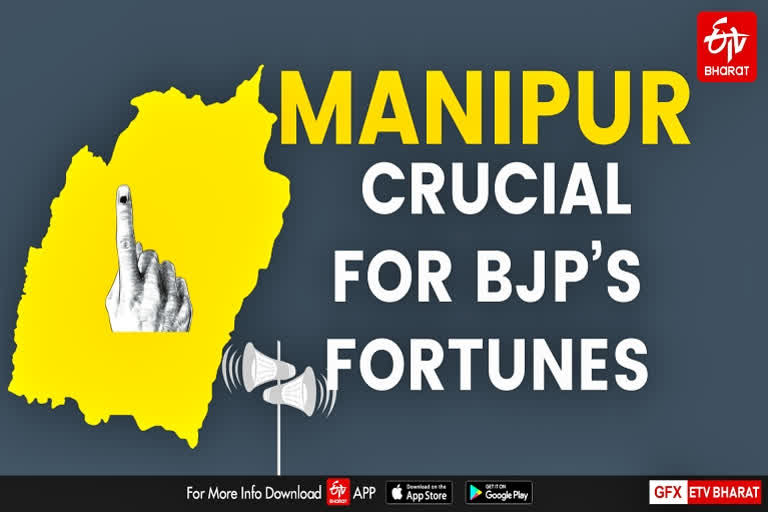New Delhi: When Manipur votes in the two-phased state elections on February 28 and March 5, there will be much more than the usual number of people outside the state watching it with riveted interest. Among the most interested will be BJP strategists in New Delhi as a win in Manipur is crucial for the eastward march of the saffron party and also to bring traction to the much-touted but much-delayed Act East Policy (AEP). The AEP, a key BJP-led NDA policy, is primed to leverage Northeast India’s close cultural and ethnic ties to connect with the South-East Asian nations beginning from Myanmar and eastwards right up to Japan.
Besides the usual agenda of development, there are two crucial issues in the Manipur polls—the Naga negotiations and the Armed Forces Special Powers Act (AFSPA). The catch is that whoever gets to form the government in the state will have to keep the considerations of the majority Meiteis in mind, for whom both issues are very emotive ones.
“The elections in Manipur have become extremely tricky this time with the apprehension of the dominant Meitei community towards the Naga peace process playing a very significant role. Whoever wins will have to cater to the wishes of the Meiteis if the support base in the densely-populated Valley is to be maintained. The second issue is of course the AFSPA,” says Prof Kumar Sanjay Singh, who teaches history in a Delhi University college besides tracking developments in the Northeast India.
A BJP government in Imphal will be under pressure to put the negotiations on the vexed Naga issue between the government and the Isak-Muivah faction of the National Socialist Council of Nagaland — NSCN (IM) on the backburner. The NSCN (IM) is Tangkhul Naga-dominated who mainly hail from the Manipur hills with Ukhrul district gradually replacing Nagaland as the epicenter of Naga insurgency.
Also read: Manipur seeks more security forces for elections due to militants threat
The Hindu Meiteis, who form about 63 percent of the state’s population, are mostly inhabitants of the Imphal Valley. Of the about 35 percent tribal populace who mostly inhabit the hills, about 20 percent are Nagas while about 15 percent are of Kuki-Chin lineage. The rest about 2 percent comprise Bengalis, Nepalis and others. The total number of seats in the Manipur assembly is 60, of which 40 are in the Meitei-dominated valley with the remaining 20 in the tribal-dominated hills almost evenly divided between the Nagas and the Kukis.
With the farmers’ agitation having eroded notable support for the BJP in western Uttar Pradesh which went to the polls on Thursday, and its political influence stymied in east India by Mamata Bannerjee’s Trinamool in Bengal, the Naveen Patnaik-led Biju Janata Dal (BJD) in Odisha and the Hemant Soren-led Jharkhand Mukti Morcha (JMM) in Jharkhand, it is vitally important for the BJP to consolidate its base in the Northeast. BJP’s southward foray has also been blunted to a large extent in Tamil Nadu, and Kerala.
What would concern BJP strategists is the strong possibility that an adverse result for the BJP in Manipur would have a domino effect in the other states of the region especially in Christian-dominated Nagaland, Mizoram, and Meghalaya, where the saffron party has to ally with other parties. Assam, Manipur, Tripura and Arunachal Pradesh are the four states in the region where the BJP can hope to form a government on its own.
The BJP’s problems are myriad also because of the fact that the Congress and its organizational structure remain intact in many stretches of the state. On the other hand, Nagaland CM Neiphiu Rio-founded Naga People's Front (NPF), Meghalaya CM Conrad Sangma-led National People's Party (NPP) and the Janata Dal (United) are expected to put in strong performances this time.
“With demands for removal of the AFSPA, the NPP is smelling blood now of gaining electoral dividends and that is the reason why it did not enter into a pre poll alliance with its partner the BJP,” points out Prof Singh. A case in point is the fact that in the 2017 state polls, the BJP had bagged 21 seats while the Congress had won in 28 ending up as the largest single party in the state. Last but not the least is that the saffron party in the state has been plagued by considerable infighting with many BJP candidates joining other parties.
Just to cite an instance, the JDU, which was a virtual non entity in the state till sometime back has garnered confidence to field candidates in 42 constituencies this time, with at least 10 of them having switched over from the BJP.



